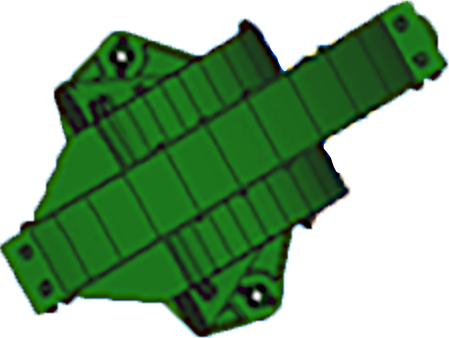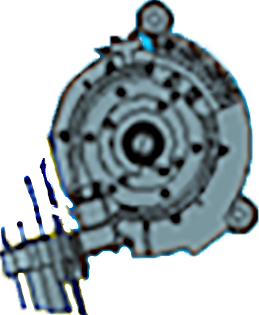Instrument Overview
Design Specifications | Pocket Guide


Pick-off mirror (POM) assembly
The pick-off mirror is attached to the focus and alignment mechanism (FAM). It is the first element on the telescope to receive light and ensures correct mapping of the NIRCam pupil onto the telescope exit pupil.
The pick-off mirror is attached to the focus and alignment mechanism (FAM). It is the first element on the telescope to receive light and ensures correct mapping of the NIRCam pupil onto the telescope exit pupil.

 Prototype pick-off mirror
Prototype pick-off mirror

Coronagraph
The coronagraph partially shields incoming starlight by inserting a mask in front of a target star, boosting the relative signal of fainter nearby companions. NIRCam is equipped with five coronagraphic masks — three round masks and two bar-shaped masks — that suppress starlight under different conditions of contrast and separation between the star and its companions. Click the number 2 to read more about coronagraphy with NIRCam.
The coronagraph partially shields incoming starlight by inserting a mask in front of a target star, boosting the relative signal of fainter nearby companions. NIRCam is equipped with five coronagraphic masks — three round masks and two bar-shaped masks — that suppress starlight under different conditions of contrast and separation between the star and its companions. Click the number 2 to read more about coronagraphy with NIRCam.
 Image from jwst-docs.stsci.edu: Diffraction from the NIRCam occulting masks (top row) and Lyot stops designed to suppress diffracted light (bottom row) from the round occulters (left) and bar occulters (right). In all images, white indicates light transmission. Adapted from Mao et al. 2011, Figure 3.
Image from jwst-docs.stsci.edu: Diffraction from the NIRCam occulting masks (top row) and Lyot stops designed to suppress diffracted light (bottom row) from the round occulters (left) and bar occulters (right). In all images, white indicates light transmission. Adapted from Mao et al. 2011, Figure 3.

First fold mirror
The first fold mirror (3) and the short wavelength fold mirror (11) serve to bend the light path to enable NIRCam to fit into as small a package as possible.
The first fold mirror (3) and the short wavelength fold mirror (11) serve to bend the light path to enable NIRCam to fit into as small a package as possible.

Collimator lens group
The collimator transmits over the entire 0.6 – 5.0 micron band. Most of the optical power is in the ZnSe lens with the other two largely providing color correction.
The collimator transmits over the entire 0.6 – 5.0 micron band. Most of the optical power is in the ZnSe lens with the other two largely providing color correction.
 From Burriesci 2004
From Burriesci 2004


Dichroic beamsplitter
The dichroic beamsplitter is used by each module to observe simultaneously in the shortwave (0.6–2.3 microns) and longwave (2.4–5.0 microns) channels. The beamsplitter is made of Si which greatly reduces problems with short wavelength filter leaks in LW arm.
The dichroic beamsplitter is used by each module to observe simultaneously in the shortwave (0.6–2.3 microns) and longwave (2.4–5.0 microns) channels. The beamsplitter is made of Si which greatly reduces problems with short wavelength filter leaks in LW arm.


Longwave filter wheel assembly
The dual wheel assembly (6 and 9) has a pupil wheel and a filter wheel, twelve positions each, in a back-to-back arrangement. Wheels are essential for wavefront sensing as they carry the weak lenses and the dispersed Hartmann sensor. Click the number 6 to read more about NIRCam filters.
The dual wheel assembly (6 and 9) has a pupil wheel and a filter wheel, twelve positions each, in a back-to-back arrangement. Wheels are essential for wavefront sensing as they carry the weak lenses and the dispersed Hartmann sensor. Click the number 6 to read more about NIRCam filters.



Longwave camera lens group
Camera triplets (7 and 10) come in two kinds for the two arms of NIRCam. They use the same AR coatings as on the collimator because they give good performance and it is cheaper to use the same coatings everywhere.
Camera triplets (7 and 10) come in two kinds for the two arms of NIRCam. They use the same AR coatings as on the collimator because they give good performance and it is cheaper to use the same coatings everywhere.


Longwave focal plane
NIRCam has two types of detectors: a 2.5 μmm cutoff and a 5 μmm cutoff HgCdTe. The detectors' basic performance is excellent with read noise ~7 e- in 1000 secs, dark current < 0.01 e/sec, and QE > 80%. Other performance factors such as latent images and linearity are excellent, as well.
NIRCam has two types of detectors: a 2.5 μmm cutoff and a 5 μmm cutoff HgCdTe. The detectors' basic performance is excellent with read noise ~7 e- in 1000 secs, dark current < 0.01 e/sec, and QE > 80%. Other performance factors such as latent images and linearity are excellent, as well.
 Qual focal plane assembly mated to the application-specific integrated circuits (ASICs).
Qual focal plane assembly mated to the application-specific integrated circuits (ASICs).

Shortwave filter wheel assembly
The dual wheel assembly (6 and 9) has a pupil wheel and a filter wheel, twelve positions each, in a back-to-back arrangement. Wheels are essential for wavefront sensing as they carry the weak lenses and the dispersed Hartmann sensor. Click the number 9 to read more about NIRCam filters.
The dual wheel assembly (6 and 9) has a pupil wheel and a filter wheel, twelve positions each, in a back-to-back arrangement. Wheels are essential for wavefront sensing as they carry the weak lenses and the dispersed Hartmann sensor. Click the number 9 to read more about NIRCam filters.



Shortwave camera lens group
Camera triplets (7 and 10) come in two kinds for the two arms of NIRCam. They use the same AR coatings as on the collimator because they give good performance and it is cheaper to use the same coatings everywhere.
Camera triplets (7 and 10) come in two kinds for the two arms of NIRCam. They use the same AR coatings as on the collimator because they give good performance and it is cheaper to use the same coatings everywhere.


Shortwave fold mirror
The first fold mirror (3) and the short wavelength fold mirror (11) serve to bend the light path to enable NIRCam to fit into as small a package as possible.
The first fold mirror (3) and the short wavelength fold mirror (11) serve to bend the light path to enable NIRCam to fit into as small a package as possible.

Pupil imaging lens
A pupil imaging lens was added to the NIRCam shortwave arm to aid with wavefront sensing tasks. This mechanism has a strong spring to pull the lens out of the beam if necessary. The rotary motor is the same type as is used in the filter wheels.
A pupil imaging lens was added to the NIRCam shortwave arm to aid with wavefront sensing tasks. This mechanism has a strong spring to pull the lens out of the beam if necessary. The rotary motor is the same type as is used in the filter wheels.

 Image taken using pupil imaging lens
Image taken using pupil imaging lens

Shortwave focal plane
NIRCam has two types of detectors: a 2.5 μmm cutoff and a 5 μmm cutoff HgCdTe. The detectors' basic performance is excellent with read noise ~7 e- in 1000 secs, dark current < 0.01 e/sec, and QE > 80%. Other performance factors such as latent images and linearity are excellent, as well.
NIRCam has two types of detectors: a 2.5 μmm cutoff and a 5 μmm cutoff HgCdTe. The detectors' basic performance is excellent with read noise ~7 e- in 1000 secs, dark current < 0.01 e/sec, and QE > 80%. Other performance factors such as latent images and linearity are excellent, as well.
 Qual shortwave focal plane assembly being readied for performance tests
Qual shortwave focal plane assembly being readied for performance tests
 Qual shortwave focal plane assembly in the cryo metrology dewar
Qual shortwave focal plane assembly in the cryo metrology dewar
Design Specifications
NIRCam has two instrument modules pointing to adjacent fields of view, and can observe two wavelengths simultaneously using dichroics. It has five observing modes, including imaging of two 2.2' by 2.2' fields of view, coronagraphic imaging, wide field slitless spectroscopy using grisms, time-series imaging, and grism time series.
The parameters presented here are largely "as built" values. Small changes may still result from updates on the telescope performance.
The key design features are (see pocket guide for illustration):
- Nyquist-sampled imaging at 2 and 4 microns — short wavelength sampling is 0.0317"/pixel and long wavelength sampling is 0.0648"/pixel
- 2.2' x 4.4' field of view for one wavelength provided by two identical imaging modules; two wavelengths observable simultaneously via dichroics
- Wavelength coverage from 0.6 to 5 microns
- A selection of broad, intermediate, and narrow band filters
- Choice of pupil positions for imaging, coronagraphy, or wavefront sensing
- Coronagraphic spots in the telescope focal plane on both modules and coronagraphic masks in the pupil wheel
- R~1700 grisms in the long wavelength arms (two per module oriented at 90° relative to each other); approximate dispersion is 0.00100 microns/pixel. Grisms need to be used in series with a bandpass filter in the filter wheel.
